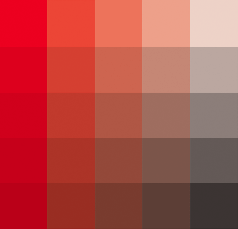red -
Red pigments include:
Like: Just as red sits on top
of the rainbow, you like to stay on top of things. You have a zest
for life. Remember that red can speed up the pulse, increase the
respiration rate and raise blood pressure. It is associated with
fire, heat, and blood, so it is impossible to ignore. And so are
you (or would like to be). The key words associated with red are
winner, achiever, intense, impulsive, active, competitive, daring,
aggressive and passionate. Red people are exciting, animated,
optimistic, emotional and extroverted. Desire is the key word,
they hunger for fullness of experience and living.
You have a zest
for life. Remember that red can speed up the pulse, increase the
respiration rate and raise blood pressure. It is associated with
fire, heat, and blood, so it is impossible to ignore. And so are
you (or would like to be). The key words associated with red are
winner, achiever, intense, impulsive, active, competitive, daring,
aggressive and passionate. Red people are exciting, animated,
optimistic, emotional and extroverted. Desire is the key word,
they hunger for fullness of experience and living.
Now that you have all the good news, let's hear it for the bad
news. Since you crave so much excitement in your life, routine
can drive you bananas. Restlessness can make you fickle in your
pursuit of new things to turn you on. It is hard for you to be
objective and you can be opinionated. You have a tendency to listen
to what others tell you and then do whatever you please. Patience
is not one of your virtues.
However, you are an exciting person to be with, and always stimulating.
The world would be a dull place without red people.
Dislike: Since red is primarily associated with a zest for life,
excitement and passion, a dislike of this hue could mean that
these feelings are a bit much for you to handle at this point
in your life. Perhaps you are bothered by the aggressiveness and
intensity that red signifies. Or perhaps you would really like
more fulfillment but are afraid to get involved. People who are
irritable, ill exhausted, or bothered by many problems often reject
red and turn to the calmer colors for rest and relaxation. They
are very self-protective.

Produced when light strikes an object and then reflects back to the eyes.
An element of art with three properties: (1) hue or tint, the color name, e.g., red, yellow, blue, etc.: (2) intensity, the purity and strength of a color, e.g., bright red or dull red; and (3) value, the lightness or darkness of a color.
When the spectrum is organized as a color wheel, the colors are divided into groups called primary, secondary and intermediate (or tertiary) colors; and also as warm and cool colors.
Colors can be objectively described as saturated, clear, cool, warm, subdued, grayed, tawny, mat, glossy, monochrome, multicolored, particolored, variegated, or polychromed.
Some words used to describe colors are more subjective (subject to personal opinion or taste), such as: exciting, sweet, saccharine, brash, garish, ugly, beautiful, cute, pretty, and sublime.
Sometimes people speak of colors when they are actually refering to pigments, what they are made of (various natural or synthetic substances), their relative permanence, etc.
Photographers measure color temperature in degrees kelvin (K).
Also see CMYK, local color, monochrome, palette, Pantone Matching System (PMS), pattern, pigment, RGB, saturation, spectrum, texture, and value.
Coming soon (available now only in early stages of construction): articles on individual colors: magenta, red, orange, yellow, green, blue, violet, purple, brown, white, gray, and black.
https://inform.quest/_art